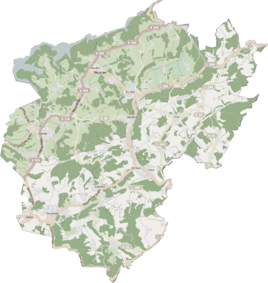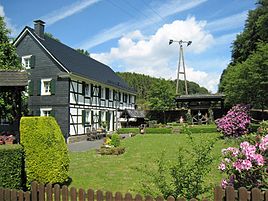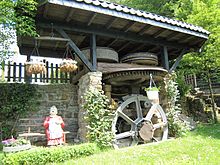Weyermühle
|
Weyermühle
Kurten municipality
Coordinates: 51 ° 1 ′ 15 ″ N , 7 ° 12 ′ 59 ″ E
|
||
|---|---|---|
| Postal code : | 51515 | |
| Area code : | 02207 | |
|
Location of Weyermühle in Kürten |
||
|
The Weyermühle 2016
|
||
Weyermühle is a district in the municipality of Kürten in the Rheinisch-Bergisches Kreis . Originally the Weyerhof was here as the predecessor of the mill.
history
The Weyerhof
The Gut zum Weyer must have existed as early as the 15th century. The Weyerhof was first mentioned in a document on December 2, 1666. Together with the neighboring farms Hauserhof , Blissenbacher Hof and the hamlet of Meiswinkel, it belonged to the “Obersand” exclave in the parish of Sand . Due to this curiosity, the residents were not allowed to visit the nearby church in Dürscheid or the church a little further away in Herrenstrunden for the prescribed church service, but were regularly forced to walk the long way beyond the two parishes to Sand. The situation was similar for political affiliation, because Obersand belonged to the Sand in the messenger office ; Gladbach and not to the neighboring Dürscheid in the Herkenrath messenger office.
The Charter of the Duchy of Berg in 1789 by Carl Friedrich von Wiebeking confirmed that the Weyerhof part at this time of the Honschaft Dürscheid lying exclave of Honschaft sand in the parish sand in office Porz was. Wiebeking names the place as Weyer .
The Weyermühle
The Weyerhof, which was free aristocratic until 1780, passed into the possession of the married couple Caspar Neuenhaus and Elisabeth D Körper from this point on . After her death, Johann Schmitz, as a co-heir of the Weyerhof, applied for a license to build a mill. With the support of the order administrator of the Johanniterkommende Herrenstrunden Hofrat Coomans , Schmitz received permission on June 23, 1798. The concession document has the following text:
"We Carl Theodor by God's grace, Pfanzgraf by Rhine, Duke in Upper and Lower Rhine of the Holy Roman Empire, Archdean and Elector of Jülich, Kleve and Berg, Duke Landgrave of Luchtenberg, Prince of Mörs, Marquis of Bergen op Zoom, Graf zu Valdenz, Sponheim der Mark and Ravensberg, Herr zu Ravenstein: Thun announce and hereby confess for our heirs and descendants, which Johann Schmitz for gracious permission to build a new grain mill on the Dürscheidsbach, Porz district, and we after that from our waiters The report requested there have graciously consented to this most submissive request, to the extent that we hereby and by virtue of this doing, so in such a way that the concessionatus of this mill should annually remove five Reichstaler edicts of water knowledge in our Kellnerey Porz. "
The newly built mill was put into operation in September 1799. The mill is driven by the Weyerbach , which gave its name to the mill and the farm. According to the interpretation of the local history association, the name comes from the word Weyer or Weier , which means water stagnation.
Under the French administration between 1806 and 1813 the Porz office was dissolved and the parish of Sand, to which the Weyermühle also belonged, was politically assigned to the Mairie Gladbach in the Mülheim am Rhein arrondissement. In 1816 the Prussians converted the Mairie to the mayor's office in Gladbach in the Mülheim am Rhein district .
The Weyermühle, together with the farms Hauserhof, Blissenbacher Hof and Meiswinkel, still belonged politically and ecclesially to the municipality of Gladbach and the parish of Sand. Now an application was made to move to the community of Bensberg combined with a move to the Dürscheid parish. After years of waiting, an unfortunate compromise was reached in 1829, with which the Upper President of the Rhine Province ordered the cadastral assignment to Bensberg. But there was no change in political or ecclesiastical affiliation. It was not until November 28, 1859 that the Royal Government of Cologne decreed in its official gazette that the boundaries for the municipality cadastre had to match the boundaries of the municipal districts. From this point on, the area belonged to the church of Dürscheid and politically to the mayor's office of Bensberg in the Mülheim am Rhein district .
In 1822, 22 people lived in the village, which was categorized as a Mahlmühle and called Weyer Mühle . In 1830 the place had 28 inhabitants and was called Weyer . The town, which was categorized as arable and fruit mill according to the overview of the government district of Cologne in 1845 , had three houses at that time. At that time, 22 residents lived in the place called Weyerhof , all of them of Catholic faith.
In 1927 the mayor's office in Bensberg was transferred to the Bensberg office. On October 1, 1932, the district reforms in Prussia created the Rheinisch-Bergische Kreis. Weyermühle has been part of this group since then.
In 1975, the current municipality of Kürten was established on the basis of the Cologne Act , to which, in addition to the departments of Kürten, Bechen and Olpe, a sub-area of the city of Bensberg with Dürscheid and thus also the Weyermühle was added.
The mill operation
So far there are no records of the first time the mill was in operation. On October 10, 1895, part of the farm buildings burned down. The mill operation was not affected by this. The entire property has been owned by the Josef Schmitz family and his descendants since 1902 . The farm also had a farm with 22 hectares of land and a bakery in a separate building. In 1923 a new wooden mill wheel was purchased, which was replaced by an iron mill wheel after the Second World War .
The mill was still in operation until 1955. The grinder was dismantled and stored in 1960. The bakery was relocated to Dürscheid in 1980. From 1997 to 1999 the mill moat was renovated and a new mill wheel made of oak was built . The grinding process was rebuilt true to the original under a protective roof in the garden. Then the 200th anniversary of the mill was held with neighbors and friends.
See also
Individual evidence
- ↑ a b c d August Hasbach: The Weyerhof and the Weyermühle near Dürscheid , in: Romerike Berge , Zeitschrift für Heimatpflege im Bergisches Land , 20th year 1970, p. 32 ff.
- ^ Wilhelm Fabricius : Explanations for the Historical Atlas of the Rhine Province ; Second volume: The map of 1789. Division and development of the territories from 1600 to 1794 ; Bonn; 1898
- ↑ Street names of the municipality of Kürten - origin and meaning. (PDF) History Association for the Municipality of Kürten and Surroundings e. V., accessed on March 20, 2017 .
- ^ Friedrich von Restorff: Topographical-statistical description of the Royal Prussian Rhine Provinces , Berlin and Stettin, 1830
- ↑ Alexander A. Mützell: New topographical-statistical-geographical dictionary of the Prussian state . tape 3 . Karl August Künnel, Halle 1822.
- ↑ Friedrich von Restorff : Topographical-statistical description of the Royal Prussian Rhine Province , Nicolai, Berlin and Stettin 1830
- ↑ Overview of the components and list of all the localities and individually named properties of the government district of Cologne: by districts, mayor's offices and parishes, with information on the number of people and the residential buildings, as well as the Confessions, Jurisdictions, Military and former state conditions. / ed. from the Royal Government of Cologne [Cologne], [1845]
- ^ GV. NRW. 1974 p. 1072
- ^ Entry on Weyermühle in the " KuLaDig " database of the Rhineland Regional Association , accessed on July 14, 2017.
literature
- Herbert Nicke : Bergische Mühlen: On the trail of the use of hydropower in the land of a thousand mills between Wupper and Sieg . Galunder Verlag, Wiehl 1998, ISBN 3-931251-36-5 , p. 266 .
- Kunibert Förster: 200 years of Weyermühle . In: History Association for the Municipality of Kürten and Surroundings e. V. (Ed.): Kürten writings . Issue 2, October 1999, p. 80 ff .
Web links
- 1999: 200 years of Weyermühle near Kürten-Dürscheid accessed on May 23, 2016
- Herbert Schmitz, master baker, born on Jan 20, 1922 in Weyermühle, accessed on May 23, 2016


